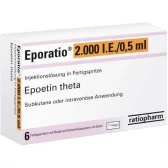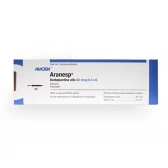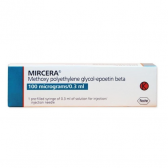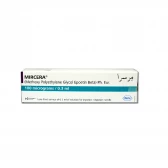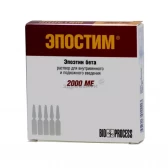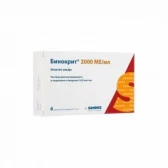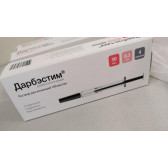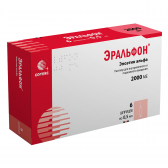Buy EPO Online | Erythropoietin For Sale | Credit Card & PayPal
Buy EPO (Erythropoietin) ▲ Frequently asked questions
What is the Normal EPO range?
The typical range per milliliter (mU / mL) is 2.3 to 18.4 milliunits. The normal ranges of values may vary slightly from one laboratory to another. Some laboratories use different measurements or test various samples. Discuss the meaning of your particular test result with your health care provider.
Secondary polycythemia can cause a higher EPO level. This is a red blood cell overproduction occurring in response to a particular situation such as low blood oxygen levels. The situation may occur at high velocities or, rarely, due to an EPO-releasing tumor.
Which diseases does Erythropoietin treat or control by prescribed medication or injections?
The most frequent use is in patients with kidney failure-associated anemia (reduced blood count). They contain less than normal quantities of erythropoietin when the kidneys are not working properly, which can result in lower production of red blood cells, or anemia. Thus, chronic inflammation related to kidney infection may be treated by substituting the erythropoietin with an intravenous infusion of synthetic erythropoietin.
Where and what physical results can be achieved with it?
For example, erythropoietin is often used by athletes in long-distance competitions, speed skateboarders, runners, and Nordic (cross-country) mountaineers as a performance-enhancing medication. It is assumed that erythropoietin is especially helpful when used in these circumstances.
Recent research has shown that cyclists or athletes who have ingested EPO help improve their endurance and efficiency by 24%.
What are the risks of taking erythropoietin?
EPO may raise the risk of endometrial cancer (the venous blood clots). A blood clot can split away from one location and move to the lung (pericardial effusion), blocking circulation. Symptoms of clots include chest pain, nausea, soreness in the legs, extreme headache, neck, or leg numbness, or stiffness.
EPO can cause blood cells to rise very high, putting the patient at an increased risk of heart failure, stroke, and death.
EPO may trigger tumor growth in patients who've had cancer. If EPO is used for these purposes, they are stopped after the patient has completed chemotherapy.
The medical practitioner will keep a keen eye on the counts of blood cells in the patient to ensure that they do not put him or her at an elevated risk. Depending on the health and condition of the patient the dosing may change.
What will happen if I have far too much or to less Erythropoietin?
Excess erythropoietin results from prolonged low oxygen levels or rare erythropoietin-producing tumors. This causes a disorder called hypoglycemia which is a high count of red blood cells. Hypoglycemia isn't causing any effects in other cases. There are, however, other general and unspecific signs of fatigue, weakness, and nausea.
If you have far less erythropoietin, typically caused by chronic kidney disease, fewer red blood cells will occur, and you will get anemia. Pharmaceutically, erythropoietin was made for the treatment of anemia that ultimately resulted from chronic kidney disease. This is also prescribed to patients of certain rarer cancer types.
Buy EPO and Erythropoietin Online - Boost Your Performance
Unveiling the Power of EPO Erythropoietin
EPO, short for Erythropoietin, is a vital hormone predominantly produced in the kidneys. Its primary function is to stimulate and regulate the production of red blood cells in the body, ensuring a sufficient supply to carry oxygen to various organs and tissues.
The Role of EPO Erythropoietin
EPO Erythropoietin plays a crucial role in enhancing athletic performance by increasing the oxygen-carrying capacity of the blood. This effect can greatly benefit athletes and individuals seeking to improve their stamina and endurance.
Original Medical Use
Originally, EPO Erythropoietin was developed to treat medical conditions characterized by low red blood cell counts, such as anemia caused by kidney disease or chemotherapy. It has revolutionized the treatment of these conditions, providing patients with improved vitality and quality of life.
EPO for Athletes
Athletes have also recognized the potential of EPO Erythropoietin to gain a competitive edge. By boosting the oxygen supply to muscles, EPO can enhance endurance, reduce fatigue, and lead to better athletic performance. However, it's important to note that the use of EPO for athletic purposes is strictly regulated and prohibited by most sports organizations due to its potential health risks and ethical concerns.
Long-Acting vs. Fast-Acting EPO
There are two main categories of EPO: long-acting and fast-acting. Understanding the differences between them is crucial:
Long-Acting EPO
- Long-acting EPO, such as Mircera, offers sustained effects over a more extended period.
- It requires less frequent administration, making it a convenient choice for certain medical conditions.
Side-Effects and Precautions
While EPO Erythropoietin can offer significant advantages, its use is not without risks:
- Side effects may include high blood pressure, headaches, and flu-like symptoms.
- Misuse or excessive dosage can lead to serious health issues, including blood clots and cardiovascular problems.
- EPO should only be used under the strict supervision of a medical professional, both for medical treatment and in adherence to anti-doping regulations in sports.
Dosage Instructions
Dosage instructions for EPO Erythropoietin can vary depending on the individual and the specific product. However, here are some general guidelines:
- The starting dose typically ranges from 50 to 100 units per kilogram (kg) and is injected into a vein or under the skin three times a week.
- Your doctor may adjust the dosage based on your response to treatment and your medical condition.
- It is essential to follow your healthcare provider's recommendations and not exceed the prescribed dosage.
EPO Erythropoietin: Time to Effect
The time it takes for EPO Erythropoietin to start showing its effects varies depending on factors such as dosage and individual response. Typically, athletes may experience improved endurance within a few weeks of use.
Doping Detection Time Frames
Detection time frames for EPO and other performance-enhancing substances vary depending on the specific method used and the individual's metabolism. Generally, EPO's detection window in urine is relatively short, approximately 12-18 hours after use[3]. This short window presents challenges for anti-doping agencies in detecting its use.

